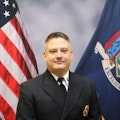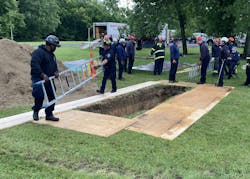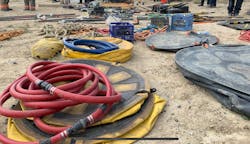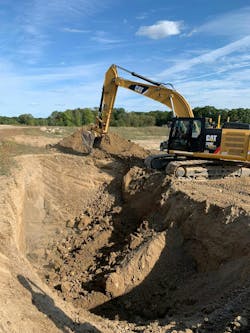Technical Rescue: Force Multiplier: Optimized Trench Rescue Involves Specialists and Regular Firefighters
Key Takeaways
- Engine and truck company members often arrive at a trench collapse before technical rescue teams do. When the latter provide basic training, informational sessions and equipment familiarization to the former, the rescue technicians can be freed up for more-technical tasks.
- When trained, firefighters who arrive on scene of a trench collapse can get to work immediately placing ground padding and ladders, conducting a size-up and performing basic air monitoring.
- Firefighters who are provided basic training by rescue technicians might emerge as recruits for the technical rescue team.
In the risk vs. frequency assessment, trench rescues certainly are high-risk events that, thankfully, don’t happen frequently. However, when these incidents occur, the imperative for the first-arriving companies and the technicians who respond to be on the same page never is greater. If that isn’t the case before incidents, incidents have the potential to spiral out of control as trained and untrained personnel, who might never have met each other, attempt to work together in a high-stress environment. When technical rescue teams include firefighters in trainings, informational sessions and equipment familiarization, gaps can be bridged before incidents occur, and the two groups can go all in at a response.
Informational sessions
Fire department training officers always are looking for out-of-the-box training ideas. Just because a department doesn’t have trench rescue capabilities doesn’t mean that its members never should be exposed to the concepts of trench rescue response. This can be as simple as the technical rescue team sending a representative to a department to provide a quick awareness-level program to cover the fundamentals. This can be a great way to get buy-in from stakeholders as to what the technical rescue team would like first-arriving companies to do and, more importantly, not do. Among the former: Explaining the importance of first-arriving companies positioning ground padding and placing ladders before the technical rescue team arrives. Further, if the first-arriving companies have the capability, they should perform basic air monitoring and ventilation as soon as possible.
Among what they shouldn’t do: Never enter an unsupported trench.
The technical rescue team also can push the size-up criteria that they desire. Is it an intersecting trench? What work was being done before the collapse? Are some shoring components installed?
Providing firefighters with a checklist also ensures a more efficient response. Items in the checklist can include eliminating vibrations; setting up scene lighting; safely moving the spoil pile; evaluating weather conditions; requesting a vacuum-type truck; and determining the collapse type and scope.
Smart devices make information-sharing easier. By laying out the important size-up considerations that are important to the technical rescue team, first-arriving companies can take photographs and videos that highlight those considerations. For example, if the first-arriving companies are made aware of how important the location of the spoil pile is and the location and/or status of heavy equipment, photos can be taken and sent to the technical rescue team while its en route. Even simple guidance on leaving space near the scene for the team’s specialized equipment saves crucial time. We never met a technical rescue team member who wants to move trench panels farther than necessary.
Training & equipment
Trench rescues are staffing-intensive and can last for several hours. Very few teams can operate in a total vacuum; more often than not, they need support from the first-arriving companies. With some basic equipment and operations-level familiarization, the first-arriving companies can become an asset to assist the technical rescue team.
When the technical rescue team holds a team drill, it should invite stakeholders with whom they might respond. Although the latter won’t be in the trench, they can learn what Airshore, OmniLock and Paratech struts are, how they go together and how they’re used. They can learn where some of the basic equipment is stored on the technical rescue team’s rig or trailer to become much more efficient runners at an incident. This isn’t to replace the importance of a team’s logistics officer but rather to act as a force multiplier.
The training will create an image in a nontrained member’s head of what the end goal looks like. Seeing the technical rescue team set up several panels with struts around the victim, placing ground pads and ladders, and conducting air monitoring all at once in a drill gives a good idea of how it all comes together. This isn’t to take the place of formalized training but rather to just give nontrained personnel an idea of how these incidents are handled and where they fit in. In some cases, technical rescue teams can use these training events to recruit new members who discover an interest in trench rescue.
Support roles
If possible, joint trainings also are good times to allow nontrained members to receive basic training on how to perform their scene support roles. Technical rescue teams should allow partner agencies to place ground pads and ladders, perform a good size-up, conduct air monitoring, and move a spoil pile safely under the technical rescue team’s instruction and guidance. This allows the operations and technician-level responders to hone their skills at their level while support personnel get a chance to get hands-on time performing the basic skills that they can safely perform. By allowing members who aren’t part of the technical rescue team to perform basic tasks, you might get the buy-in that’s desired.
Again, this isn’t to take the place of formalized training. At the scene of an incident, untrained members still must be set up for success, even with these informational sessions and training opportunities. Pairing a first-arriving member with trained members of the technical rescue team during these basic, just-in-time trainings is a best practice. Integrate the first-arriving companies into the logical team functions that are used in trench rescue. Assign one member to assist the air team, assign several to the panel and shoring teams, and assign several to help with logistics in the role of runners. This ensures that there will be little to no freelancing and that help is spread evenly throughout the team. Furthermore, any folks who are left standing around can be used to move spoil piles, etc.
Eliminating the chaos
Trench rescue incidents require an all-in mentality. Everyone, from the first-arriving company to the specialized trench rescue team boss, is there for one reason: to safely remove any and all victims from the trench. By ensuring that everyone is on the same page, from size-up to scene support, what often is a chaotic scene can be turned into what it should be: an all-in effort by all of the responders who are on scene.
About the Author

Christian Brown
Christian Brown is a 19-year lieutenant with FDNY. He has spent time in special operations and is also a special operations instructor for the state of New York. He is pursuing his bachelor’s degree in emergency management at Metropolitan College of New York.

Jeffrey Mondo
Jeffrey Mondo is a fire protection specialist with the state of New York’s Office of Fire Prevention and Control (New York State Fire) and is assigned to the Technical Rescue Branch. He also is a rescue team manager with New York Task Force 2 Urban/Technical Search and Rescue (NY-TF2). Mondo is an adjunct instructor at Onondaga Community College who is assigned to the fire protection technology program.


